We’re guessing we’re not the only ones disappointed that the Covid-19 restrictions have led to temporary closures of some of our favourite National Trust properties, stately homes, and historic gardens – and just when the sun is out and the days are getting longer! To help pass the time until we can all revisit our local historic buildings, we’re offering a virtual tour of several impressive estates – some of which are now open to the public, others we can only daydream about being invited to! – courtesy of some old masters currently offered for sale at Dickinson.
Fitzhead, Somerset
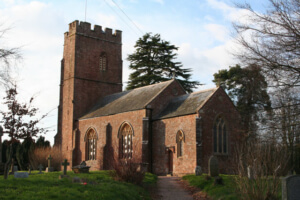

Church of St. James the Great, Fitzhead, Somerset
Fitzhead was the seat of James Ward’s great patron John Southey, 15th Lord Somerville, who commissioned this expansive view. The estate of Fitzhead Court and The Manor, which aren’t visible here, date from the late 16th century – they were sold to Alexander Baring, 1st Baron Ashburton, in 1840, and are still privately owned. We can, however, just pick out the distant form of the Church of St. James the Great, with its crenelated tower, in the middle distance. Somerset is known for its rolling hills and fertile farmland, which Ward captures here, and which make the landscape an appealing place for a country walk – especially if you’re a dog owner like Lord Somerville!
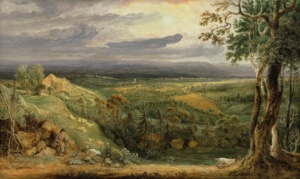

J. Ward, R.A., A View in Somersetshire from Fitzhead, the Seat of Lord Somerville, 1805, oil on panel
Luton Hoo, Bedfordshire


P. Sandby, Cattle in the park at Luton, with a Birch to the left, 1765, bodycolour on paper, within a black-lined border on the artist’s original mount
Luton Hoo Estate was acquired by John Stuart, 3rd Earl of Bute in late summer 1763 for the sum of £94,700. The existing house was deemed insufficiently grand for Bute’s plans, so he charged the celebrated architect Robert Adam with its redesign, while the fashionable landscape designer Lancelot ‘Capability’ Brown was entrusted with the layout of nearly 4,000 acres of parkland. When Paul Sandby painted these and other views in 1765, the old Palladian gatehouse was still standing; it subsequently became a casualty of the redevelopment. The house itself is now a spa hotel, and would make a luxurious destination for a weekend escape, but the grounds and walled garden are still open to the public. In fact the historic model farm is often used by filmmakers so you may even recognise the spot on screen!


P. Sandby, Cattle and Figures with an old man on a horse selling cherries, before a Palladian Gatehouse, in the park at Luton, the old house in the distance, c. 1765, pencil, pen and ink and watercolour with touches of white heightening on paper, within a black and gold-lined border on the artist’s original mount
Quenby Hall, Leicestershire
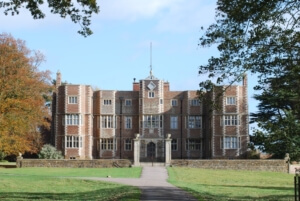

Quenby Hall, Lecestershire
Pevsner described it as ‘the most important early-seventeenth century house in the county [of Leicestershire]’, and Jacobean Quenby Hall has been listed Grade I by English Heritage. Quenby was built between 1618 and 1636 by George Ashby and remained in family possession until 1904. By the time this view was painted around 1740, perhaps by Peter Tillemans, park enclosures to control grazing had led to an increase in milk production and Quenby was known for its cheese: it boasted one of England’s earliest purpose-built Stilton dairies. This business may perhaps be obliquely referenced by the grazing cattle in the foreground. Alas, Quenby is closed to visitors, but it is available to rent for weddings – no indication of whether Stilton is on the menu…
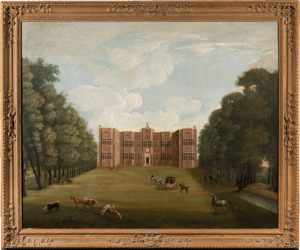

English School, Quenby Hall, c. 1740, oil on canvas
Chiswick House, Greater London
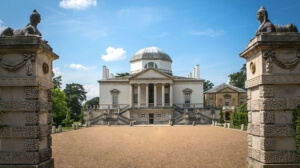

Chiswick House, Chiswick, Greater London
Neo-Palladian Chiswick House was designed and built by Richard Boyle, 3rd Earl of Burlington, and completed in 1729. It sits in a landscape designed by William Kent and today it is a Grade I listed building maintained by English Heritage and open to the public. Although much of its original art collection has since been dispersed, Chiswick was once filled with superb pieces by the likes of Sebastiano Ricci, including this Holy Family with the infant Saint John the Baptist in a landscape. It certainly hung in the East Saloon by 1845 and may even have been commissioned from Ricci by Burlington himself. Over the years Chiswick has been visited by notable historical figures including John Adams, Thomas Jefferson, Benjamin Franklin and Sir Robert Walpole, among others. We look forward to visiting Chiswick ourselves as soon as it reopens!
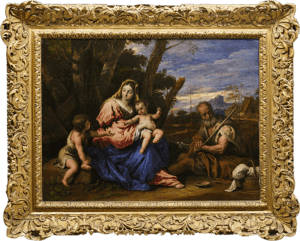

S. Ricci, The Holy Family with the infant Saint John the Baptist in a landscape, c. 1712-16, oil on canvas
Kings Weston House, Bristol
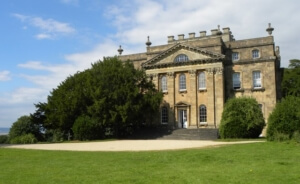

Kings Weston House, Bristol
The magnificent Kings Weston House was designed and built between 1712-19 by Sir John Vanbrugh for Anglo-Irish politician Edward Southwell on the site of an earlier Tudor house, and it remained in the Southwell family until 1833. Southwell’s son, also called Edward, was responsible for commissioning this exceptional pair of early vedute by Canaletto during his Grand Tour to Italy in 1725-26. Remarkably, the views remained in family possession until they were sold in 2001. Since 2012 this Grade I listed building surrounded by parkland and woodland has been available to rent as an events venue. We can dream…


Farnborough Hall, Warwickshire
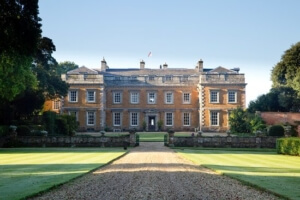

Farnborough Hall, Warwickshire
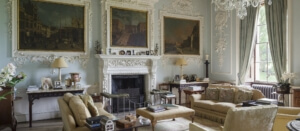

Farnborough Hall, a view of the interior
Farnborough Hall belonged to the Holbech family from 1684 until it was endowed to the National Trust in 1960. Between 1745 and 1750, the entrance was remodelled and extensive plasterwork was added to the interior to surround and show off the paintings by Canaletto and Panini brought back from Grand Tour by William Holbech. Among the treasures he bought or commissioned was Panini’s superb Rome, the Pantheon, a view of the interior (1734). Farnborough also boasts extensive gardens laid out in the mid-18th century by Sanderson Miller, and would be an ideal place to admire the spring flowers. Something to look forward to!


